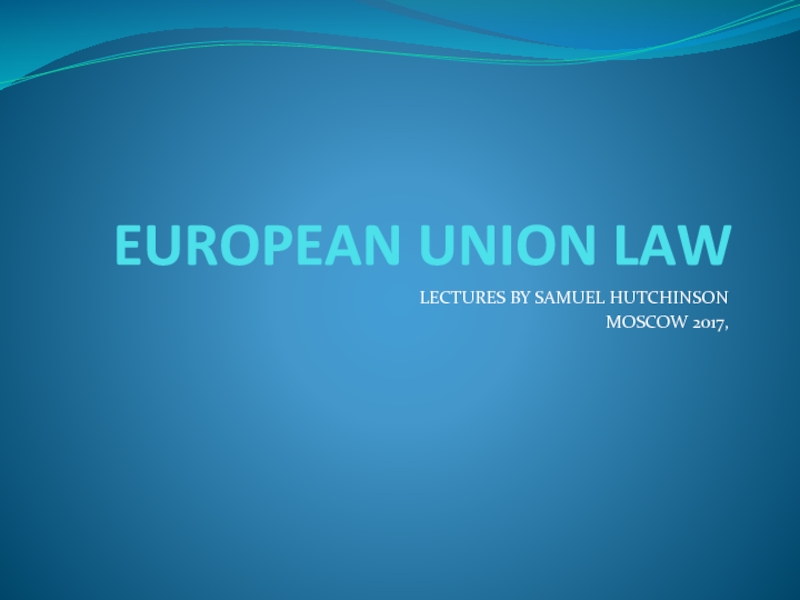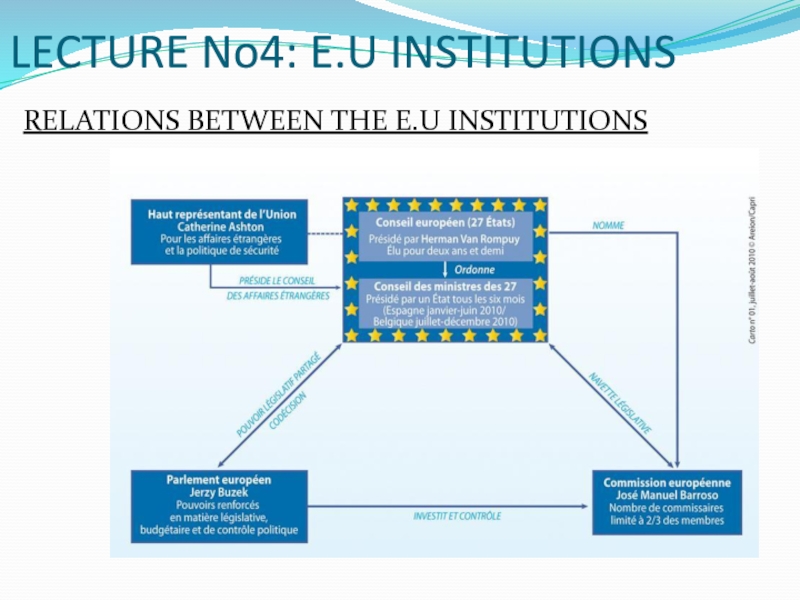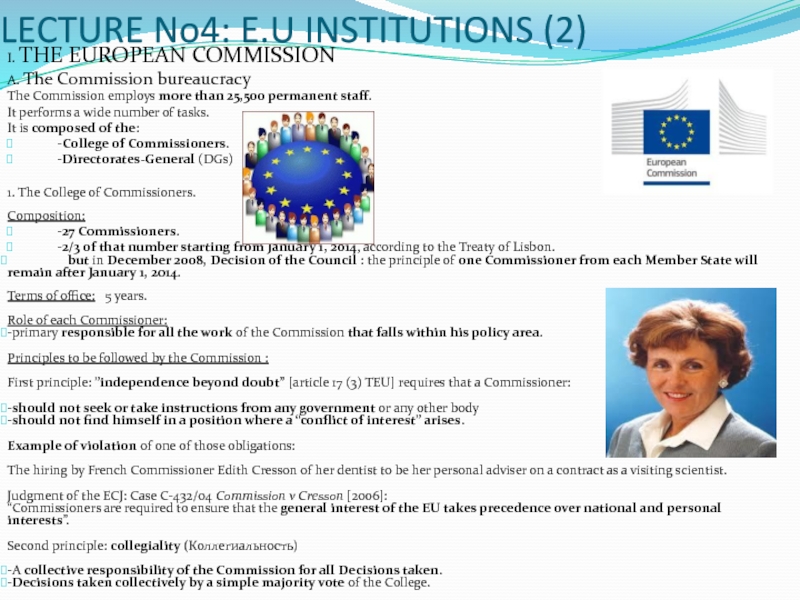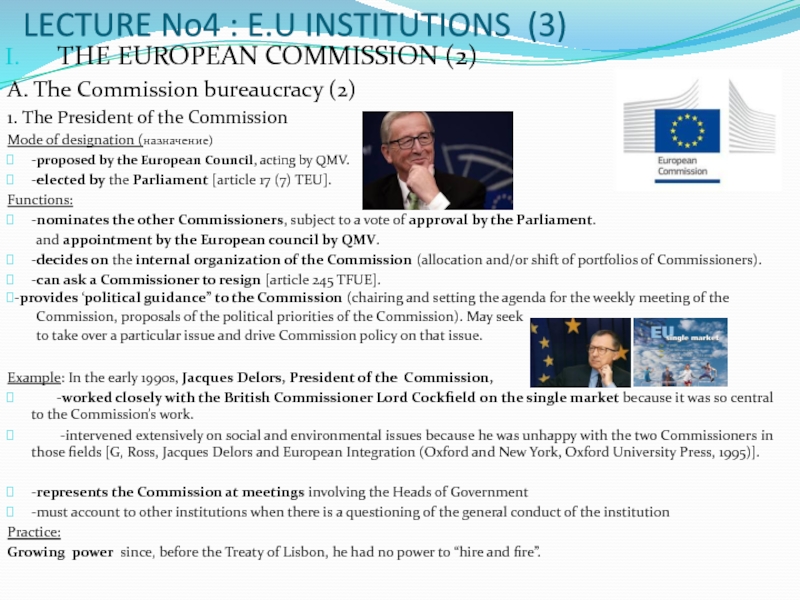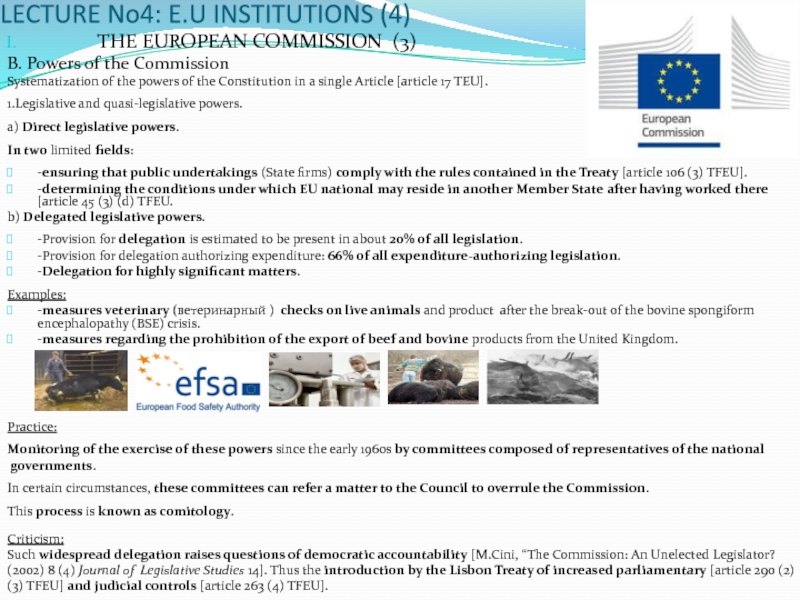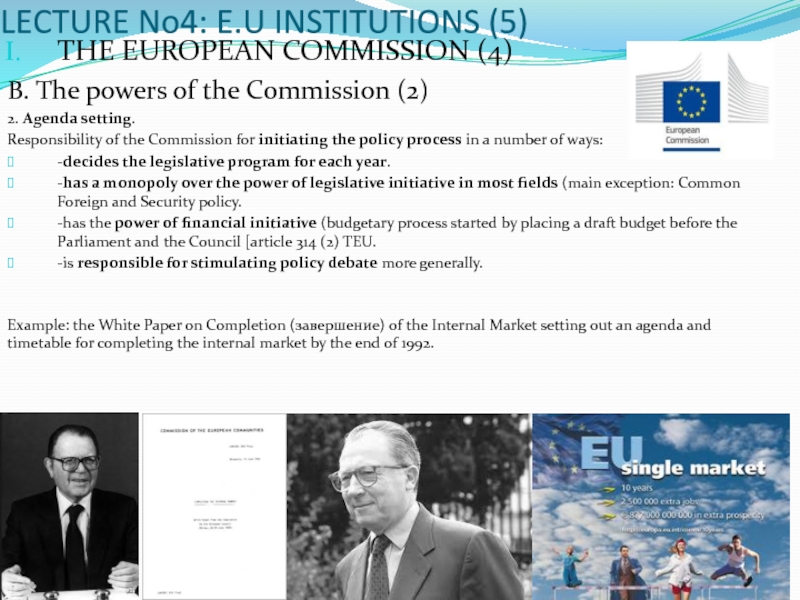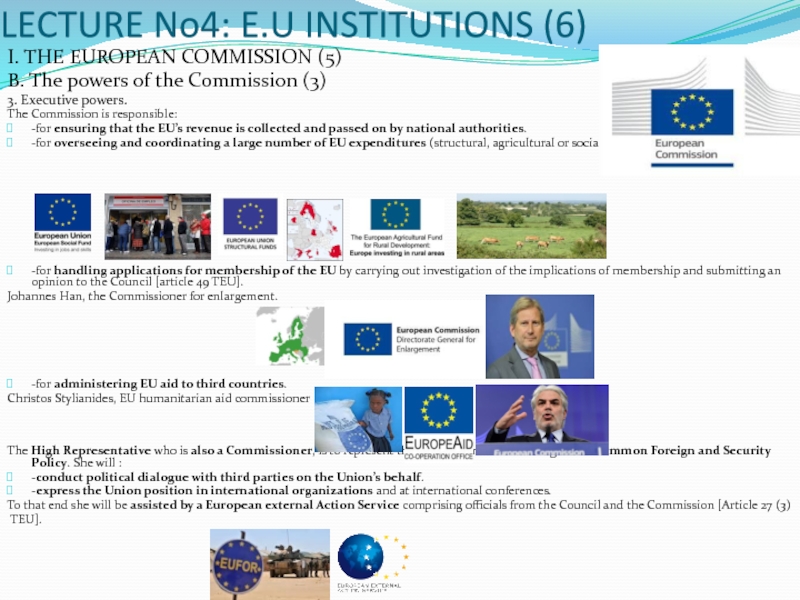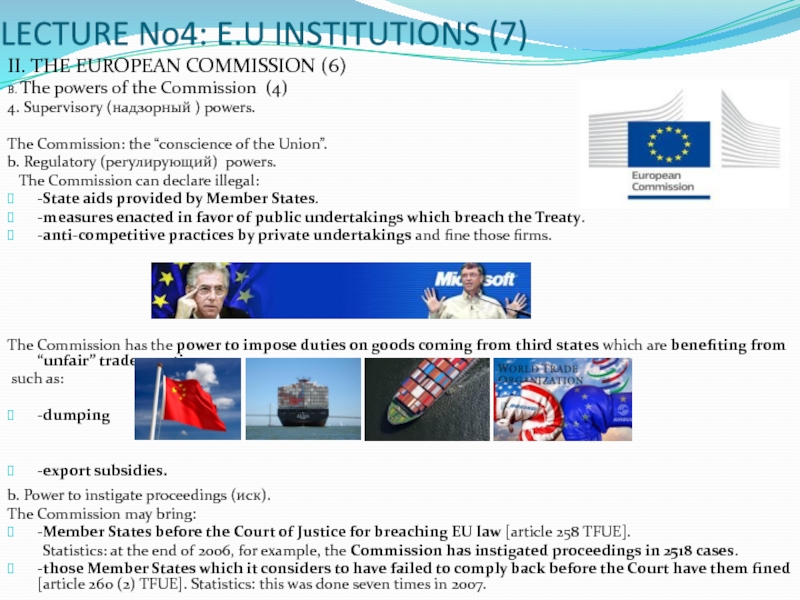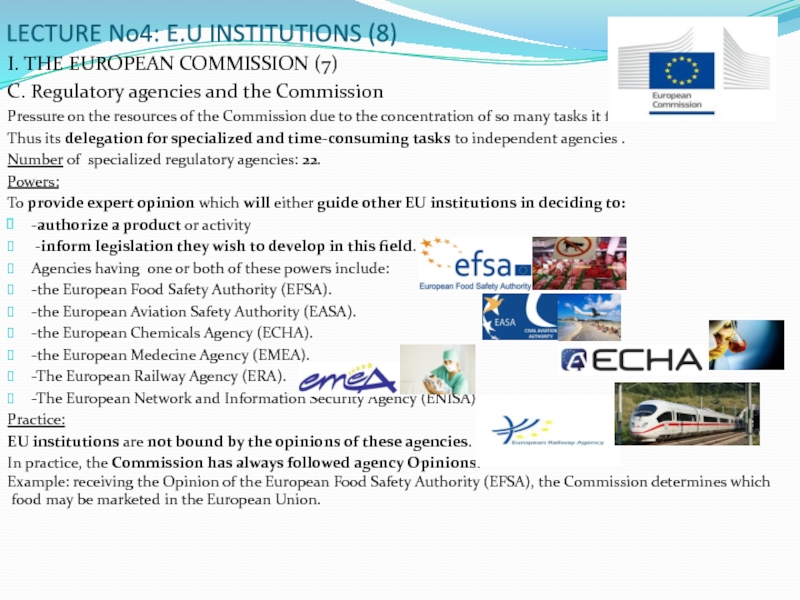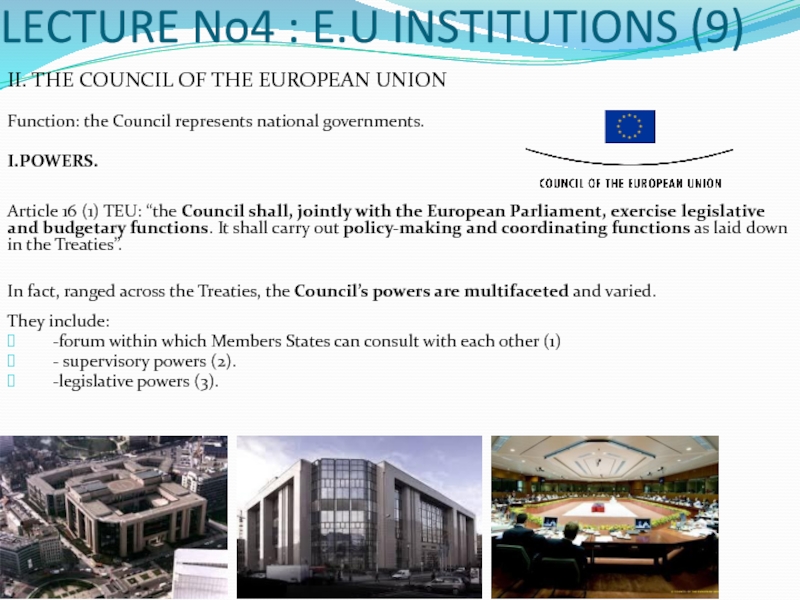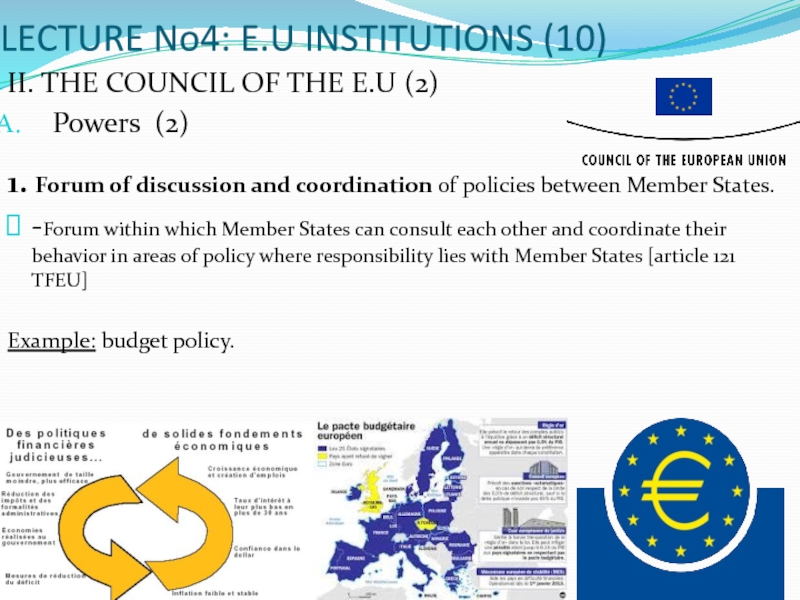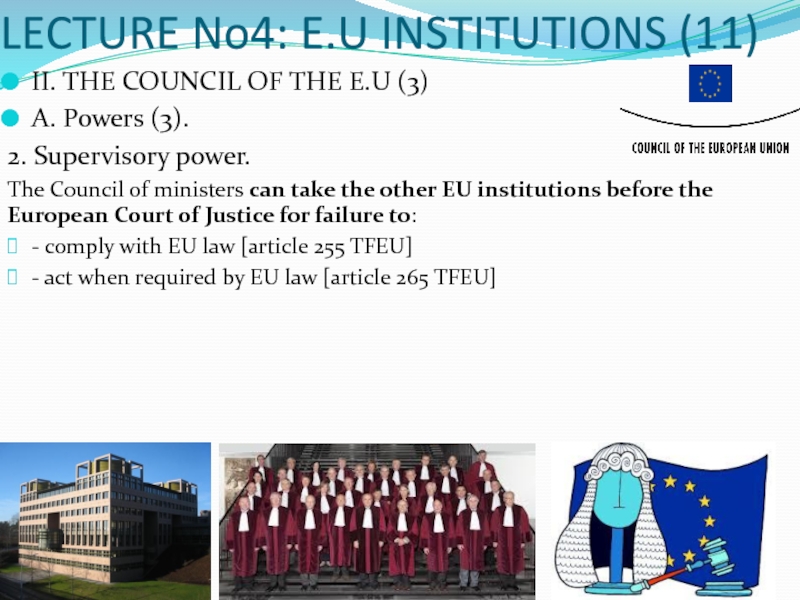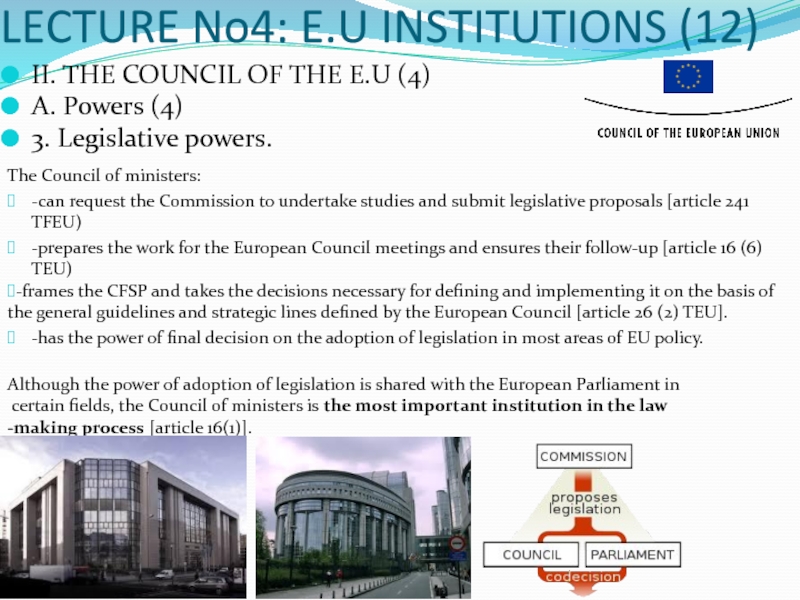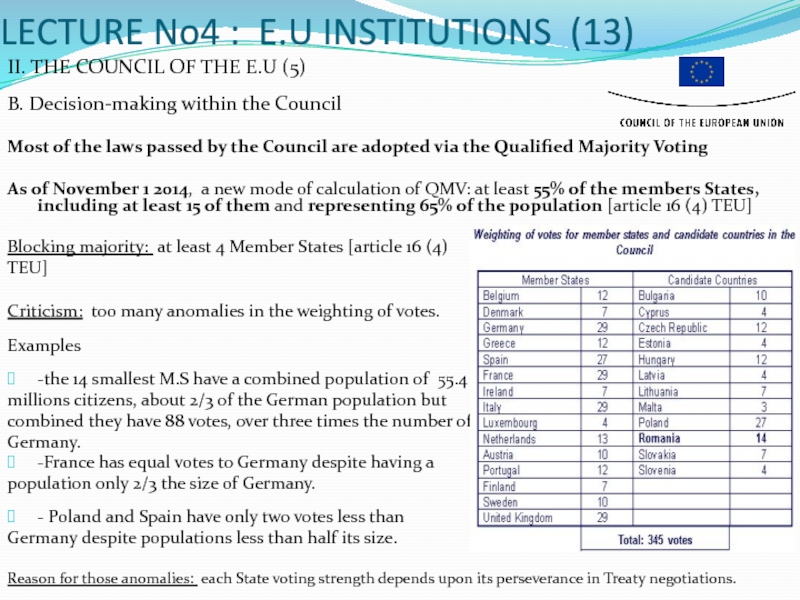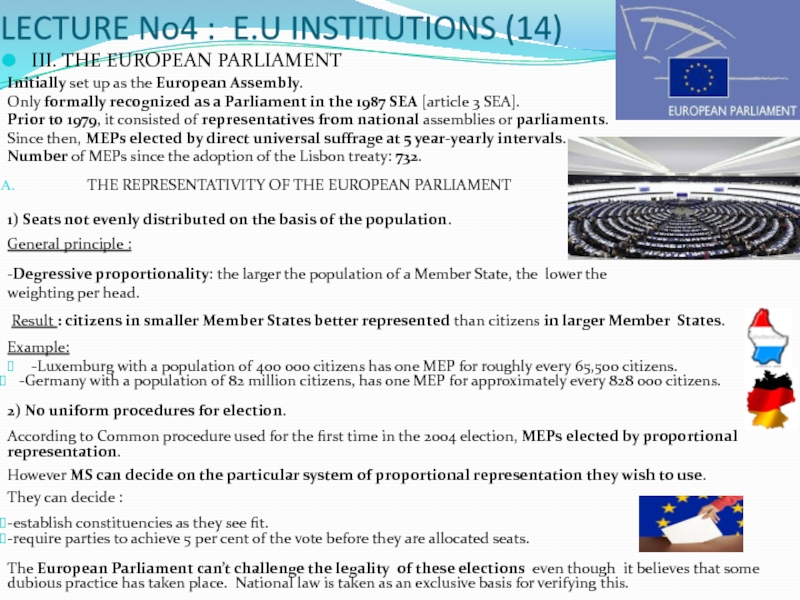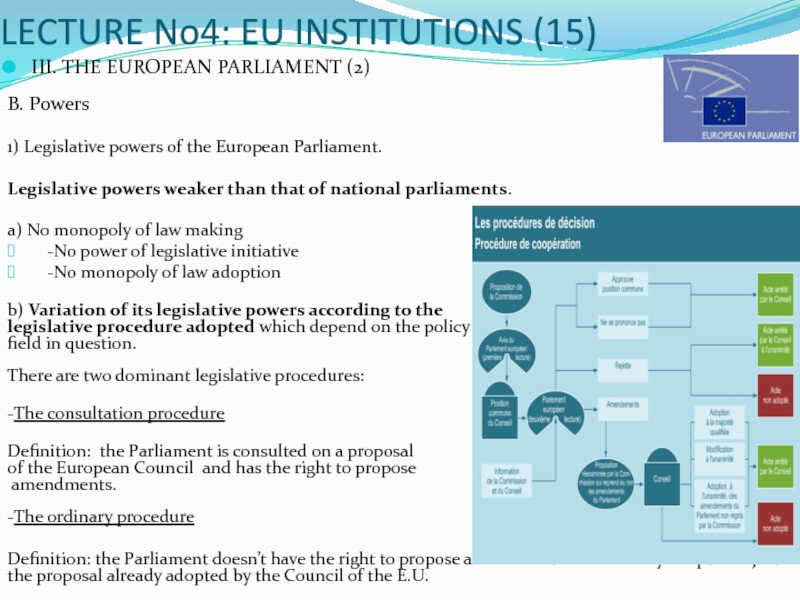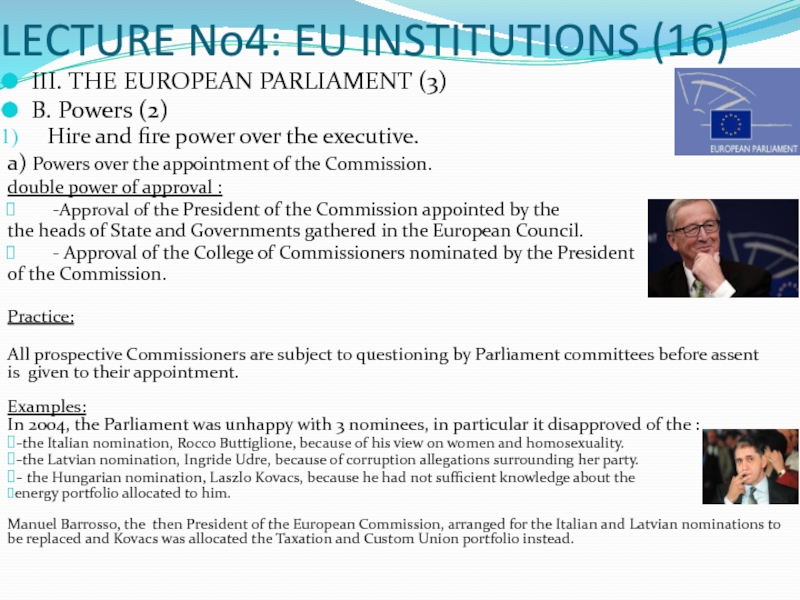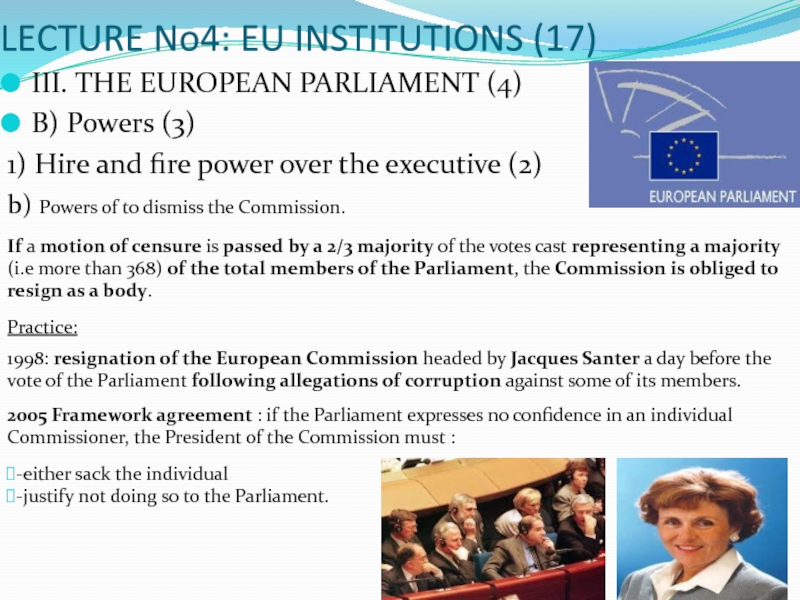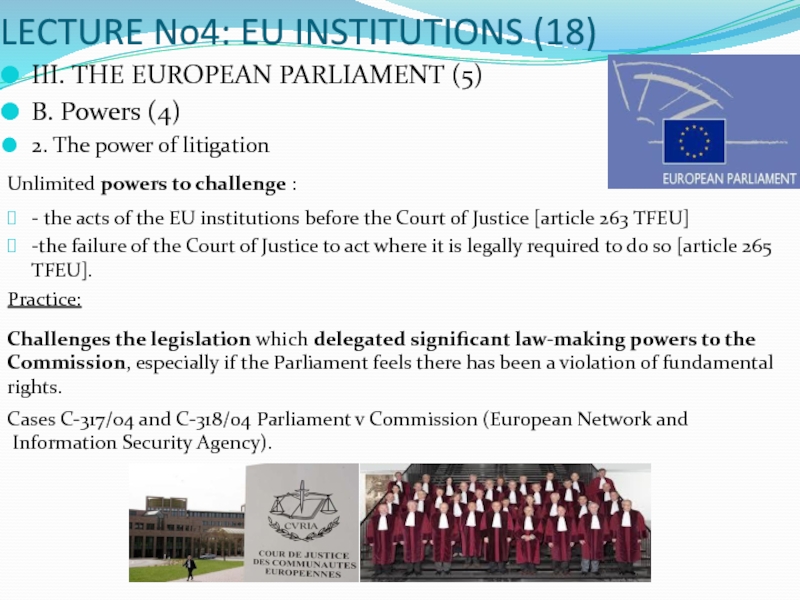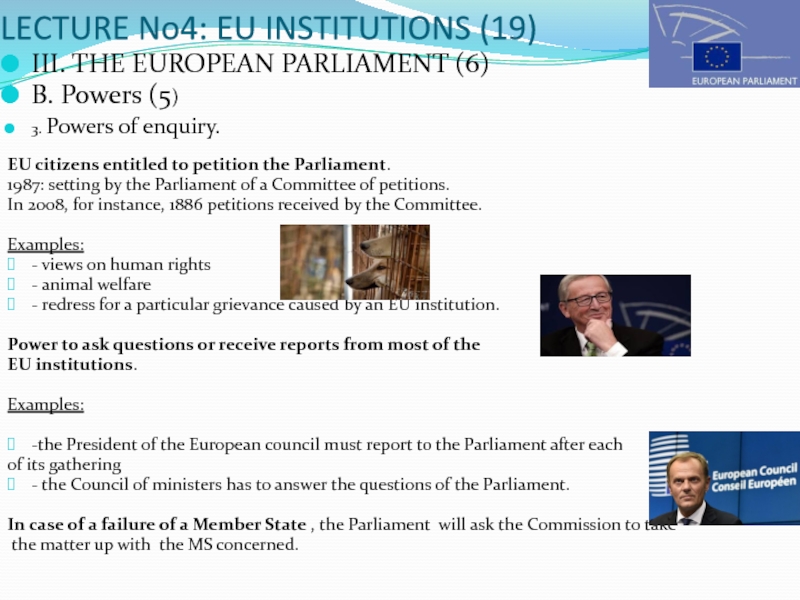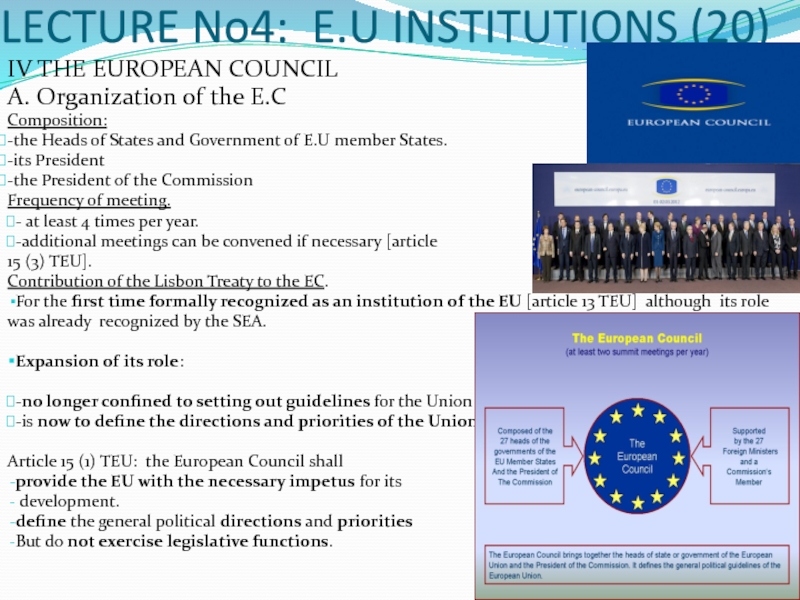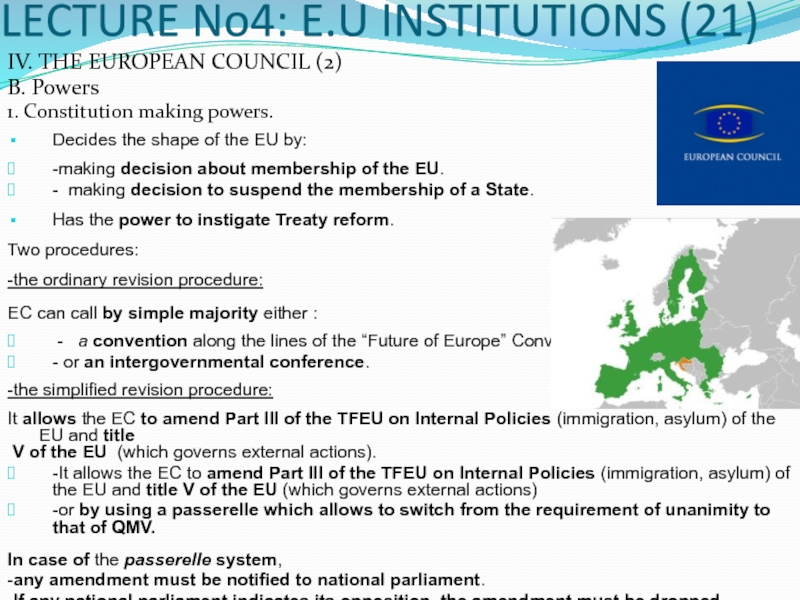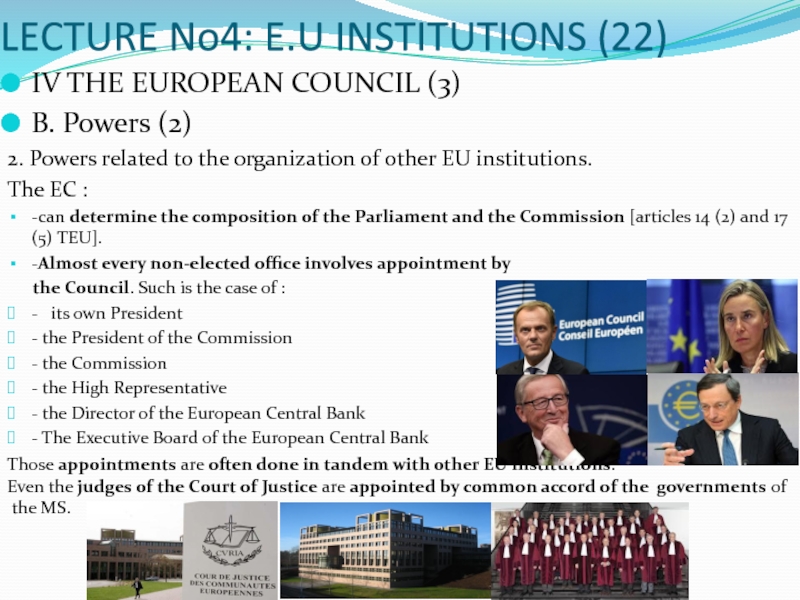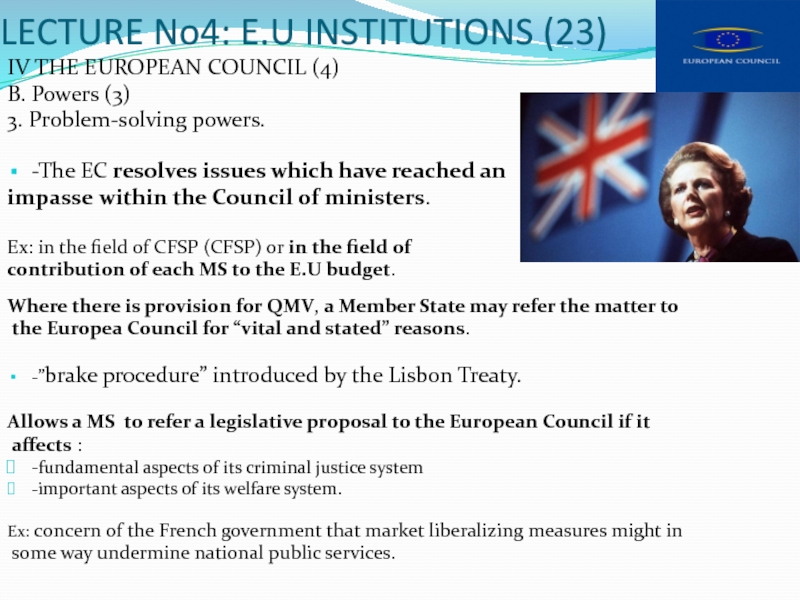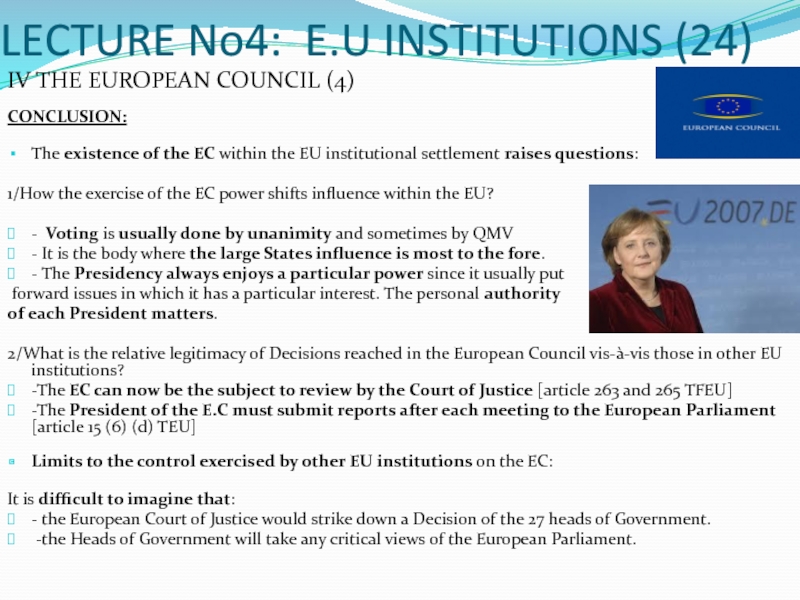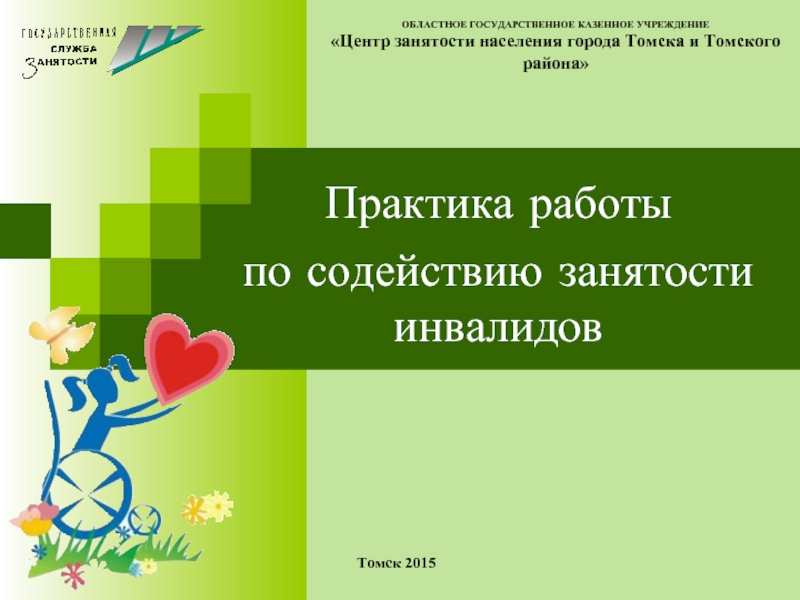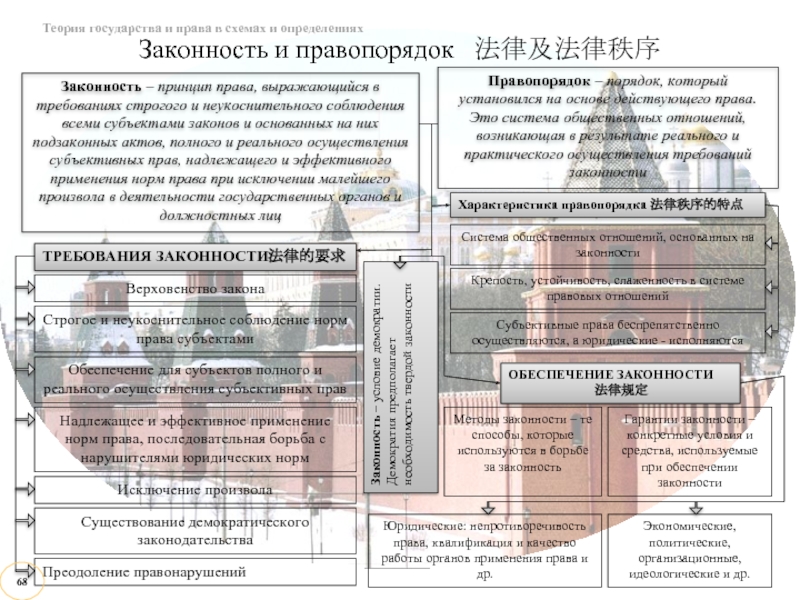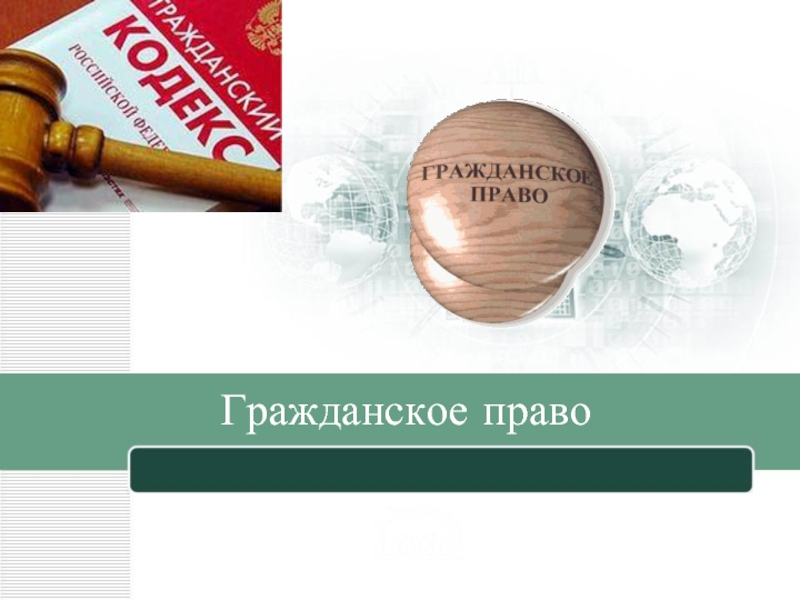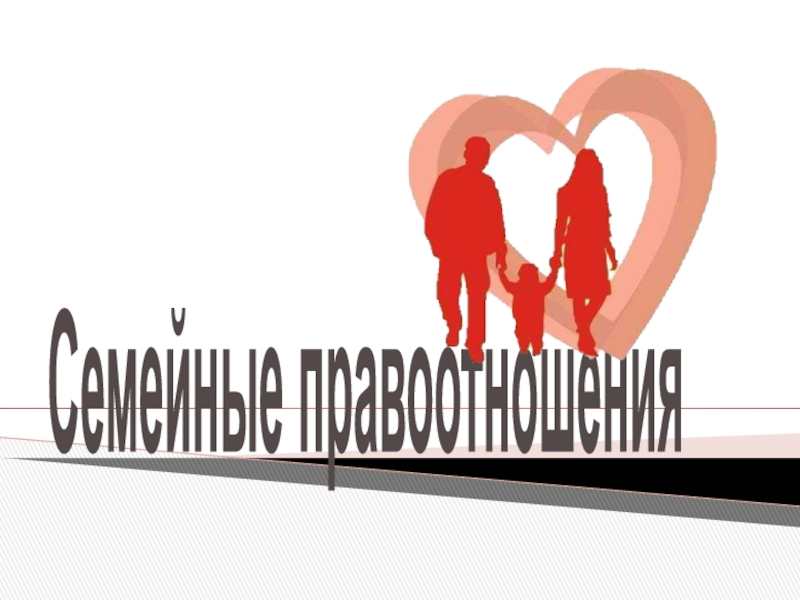- Главная
- Разное
- Дизайн
- Бизнес и предпринимательство
- Аналитика
- Образование
- Развлечения
- Красота и здоровье
- Финансы
- Государство
- Путешествия
- Спорт
- Недвижимость
- Армия
- Графика
- Культурология
- Еда и кулинария
- Лингвистика
- Английский язык
- Астрономия
- Алгебра
- Биология
- География
- Детские презентации
- Информатика
- История
- Литература
- Маркетинг
- Математика
- Медицина
- Менеджмент
- Музыка
- МХК
- Немецкий язык
- ОБЖ
- Обществознание
- Окружающий мир
- Педагогика
- Русский язык
- Технология
- Физика
- Философия
- Химия
- Шаблоны, картинки для презентаций
- Экология
- Экономика
- Юриспруденция
European Union Law презентация
Содержание
- 1. European Union Law
- 2. LECTURE No4: E.U INSTITUTIONS RELATIONS BETWEEN THE E.U INSTITUTIONS
- 3. LECTURE No4: E.U INSTITUTIONS (2) I.
- 4. LECTURE No4 : E.U INSTITUTIONS (3)
- 5. LECTURE No4: E.U INSTITUTIONS (4)
- 6. LECTURE No4: E.U INSTITUTIONS (5) THE
- 7. LECTURE No4: E.U INSTITUTIONS (6) I.
- 8. LECTURE No4: E.U INSTITUTIONS (7) II.
- 9. LECTURE No4: E.U INSTITUTIONS (8)
- 10. LECTURE No4 : E.U INSTITUTIONS (9)
- 11. LECTURE No4: E.U INSTITUTIONS (10) II.
- 12. LECTURE No4: E.U INSTITUTIONS (11) II. THE
- 13. LECTURE No4: E.U INSTITUTIONS (12) II. THE
- 14. LECTURE No4 : E.U INSTITUTIONS (13)
- 15. LECTURE No4 : E.U INSTITUTIONS (14)
- 16. LECTURE No4: EU INSTITUTIONS (15) III.
- 17. LECTURE No4: EU INSTITUTIONS (16) III.
- 18. LECTURE No4: EU INSTITUTIONS (17) III. THE
- 19. LECTURE No4: EU INSTITUTIONS (18) III.
- 20. LECTURE No4: EU INSTITUTIONS (19) III. THE
- 21. LECTURE No4: E.U INSTITUTIONS (20) IV
- 22. LECTURE No4: E.U INSTITUTIONS (21) IV. THE
- 23. LECTURE No4: E.U INSTITUTIONS (22) IV THE
- 24. LECTURE No4: E.U INSTITUTIONS (23) IV
- 25. LECTURE No4: E.U INSTITUTIONS (24) IV
Слайд 3LECTURE No4: E.U INSTITUTIONS (2)
I. THE EUROPEAN COMMISSION
A. The
Commission bureaucracy
The Commission employs more than 25,500 permanent staff.
It performs a wide number of tasks.
It is composed of the:
-College of Commissioners.
-Directorates-General (DGs)
1. The College of Commissioners.
Composition:
-27 Commissioners.
-2/3 of that number starting from January 1, 2014, according to the Treaty of Lisbon.
but in December 2008, Decision of the Council : the principle of one Commissioner from each Member State will remain after January 1, 2014.
Terms of office: 5 years.
Role of each Commissioner:
-primary responsible for all the work of the Commission that falls within his policy area.
Principles to be followed by the Commission :
First principle: ”independence beyond doubt” [article 17 (3) TEU] requires that a Commissioner:
-should not seek or take instructions from any government or any other body
-should not find himself in a position where a “conflict of interest” arises.
Example of violation of one of those obligations:
The hiring by French Commissioner Edith Cresson of her dentist to be her personal adviser on a contract as a visiting scientist.
Judgment of the ECJ: Case C-432/04 Commission v Cresson [2006]:
“Commissioners are required to ensure that the general interest of the EU takes precedence over national and personal
interests”.
Second principle: collegiality (Коллегиальность)
-A collective responsibility of the Commission for all Decisions taken.
-Decisions taken collectively by a simple majority vote of the College.
The Commission employs more than 25,500 permanent staff.
It performs a wide number of tasks.
It is composed of the:
-College of Commissioners.
-Directorates-General (DGs)
1. The College of Commissioners.
Composition:
-27 Commissioners.
-2/3 of that number starting from January 1, 2014, according to the Treaty of Lisbon.
but in December 2008, Decision of the Council : the principle of one Commissioner from each Member State will remain after January 1, 2014.
Terms of office: 5 years.
Role of each Commissioner:
-primary responsible for all the work of the Commission that falls within his policy area.
Principles to be followed by the Commission :
First principle: ”independence beyond doubt” [article 17 (3) TEU] requires that a Commissioner:
-should not seek or take instructions from any government or any other body
-should not find himself in a position where a “conflict of interest” arises.
Example of violation of one of those obligations:
The hiring by French Commissioner Edith Cresson of her dentist to be her personal adviser on a contract as a visiting scientist.
Judgment of the ECJ: Case C-432/04 Commission v Cresson [2006]:
“Commissioners are required to ensure that the general interest of the EU takes precedence over national and personal
interests”.
Second principle: collegiality (Коллегиальность)
-A collective responsibility of the Commission for all Decisions taken.
-Decisions taken collectively by a simple majority vote of the College.
Слайд 4 LECTURE No4 : E.U INSTITUTIONS (3)
THE EUROPEAN COMMISSION (2)
A. The Commission bureaucracy (2)
1. The President of the Commission
Mode of designation (назначение)
-proposed by the European Council, acting by QMV.
-elected by the Parliament [article 17 (7) TEU].
Functions:
-nominates the other Commissioners, subject to a vote of approval by the Parliament.
and appointment by the European council by QMV.
-decides on the internal organization of the Commission (allocation and/or shift of portfolios of Commissioners).
-can ask a Commissioner to resign [article 245 TFUE].
-provides ‘political guidance” to the Commission (chairing and setting the agenda for the weekly meeting of the
Commission, proposals of the political priorities of the Commission). May seek
to take over a particular issue and drive Commission policy on that issue.
Example: In the early 1990s, Jacques Delors, President of the Commission,
-worked closely with the British Commissioner Lord Cockfield on the single market because it was so central to the Commission’s work.
-intervened extensively on social and environmental issues because he was unhappy with the two Commissioners in those fields [G, Ross, Jacques Delors and European Integration (Oxford and New York, Oxford University Press, 1995)].
-represents the Commission at meetings involving the Heads of Government
-must account to other institutions when there is a questioning of the general conduct of the institution
Practice:
Growing power since, before the Treaty of Lisbon, he had no power to “hire and fire”.
Слайд 5LECTURE No4: E.U INSTITUTIONS (4)
THE EUROPEAN COMMISSION (3)
B.
Powers of the Commission
Systematization of the powers of the Constitution in a single Article [article 17 TEU].
1.Legislative and quasi-legislative powers.
a) Direct legislative powers.
In two limited fields:
-ensuring that public undertakings (State firms) comply with the rules contained in the Treaty [article 106 (3) TFEU].
-determining the conditions under which EU national may reside in another Member State after having worked there [article 45 (3) (d) TFEU.
b) Delegated legislative powers.
-Provision for delegation is estimated to be present in about 20% of all legislation.
-Provision for delegation authorizing expenditure: 66% of all expenditure-authorizing legislation.
-Delegation for highly significant matters.
Examples:
-measures veterinary (ветеринарный ) checks on live animals and product after the break-out of the bovine spongiform encephalopathy (BSE) crisis.
-measures regarding the prohibition of the export of beef and bovine products from the United Kingdom.
Practice:
Monitoring of the exercise of these powers since the early 1960s by committees composed of representatives of the national
governments.
In certain circumstances, these committees can refer a matter to the Council to overrule the Commission.
This process is known as comitology.
Criticism:
Such widespread delegation raises questions of democratic accountability [M.Cini, “The Commission: An Unelected Legislator?
(2002) 8 (4) Journal of Legislative Studies 14]. Thus the introduction by the Lisbon Treaty of increased parliamentary [article 290 (2)
(3) TFEU] and judicial controls [article 263 (4) TFEU].
.
Systematization of the powers of the Constitution in a single Article [article 17 TEU].
1.Legislative and quasi-legislative powers.
a) Direct legislative powers.
In two limited fields:
-ensuring that public undertakings (State firms) comply with the rules contained in the Treaty [article 106 (3) TFEU].
-determining the conditions under which EU national may reside in another Member State after having worked there [article 45 (3) (d) TFEU.
b) Delegated legislative powers.
-Provision for delegation is estimated to be present in about 20% of all legislation.
-Provision for delegation authorizing expenditure: 66% of all expenditure-authorizing legislation.
-Delegation for highly significant matters.
Examples:
-measures veterinary (ветеринарный ) checks on live animals and product after the break-out of the bovine spongiform encephalopathy (BSE) crisis.
-measures regarding the prohibition of the export of beef and bovine products from the United Kingdom.
Practice:
Monitoring of the exercise of these powers since the early 1960s by committees composed of representatives of the national
governments.
In certain circumstances, these committees can refer a matter to the Council to overrule the Commission.
This process is known as comitology.
Criticism:
Such widespread delegation raises questions of democratic accountability [M.Cini, “The Commission: An Unelected Legislator?
(2002) 8 (4) Journal of Legislative Studies 14]. Thus the introduction by the Lisbon Treaty of increased parliamentary [article 290 (2)
(3) TFEU] and judicial controls [article 263 (4) TFEU].
.
Слайд 6LECTURE No4: E.U INSTITUTIONS (5)
THE EUROPEAN COMMISSION (4)
B. The
powers of the Commission (2)
2. Agenda setting.
Responsibility of the Commission for initiating the policy process in a number of ways:
-decides the legislative program for each year.
-has a monopoly over the power of legislative initiative in most fields (main exception: Common Foreign and Security policy.
-has the power of financial initiative (budgetary process started by placing a draft budget before the Parliament and the Council [article 314 (2) TEU.
-is responsible for stimulating policy debate more generally.
Example: the White Paper on Completion (завершение) of the Internal Market setting out an agenda and
timetable for completing the internal market by the end of 1992.
2. Agenda setting.
Responsibility of the Commission for initiating the policy process in a number of ways:
-decides the legislative program for each year.
-has a monopoly over the power of legislative initiative in most fields (main exception: Common Foreign and Security policy.
-has the power of financial initiative (budgetary process started by placing a draft budget before the Parliament and the Council [article 314 (2) TEU.
-is responsible for stimulating policy debate more generally.
Example: the White Paper on Completion (завершение) of the Internal Market setting out an agenda and
timetable for completing the internal market by the end of 1992.
Слайд 7LECTURE No4: E.U INSTITUTIONS (6)
I. THE EUROPEAN COMMISSION (5)
B. The
powers of the Commission (3)
3. Executive powers.
The Commission is responsible:
-for ensuring that the EU’s revenue is collected and passed on by national authorities.
-for overseeing and coordinating a large number of EU expenditures (structural, agricultural or social funds).
-for handling applications for membership of the EU by carrying out investigation of the implications of membership and submitting an opinion to the Council [article 49 TEU].
Johannes Han, the Commissioner for enlargement.
-for administering EU aid to third countries.
Christos Stylianides, EU humanitarian aid commissioner
The High Representative who is also a Commissioner, is to represent the Union for matters relating to the Common Foreign and Security Policy. She will :
-conduct political dialogue with third parties on the Union’s behalf.
-express the Union position in international organizations and at international conferences.
To that end she will be assisted by a European external Action Service comprising officials from the Council and the Commission [Article 27 (3)
TEU].
3. Executive powers.
The Commission is responsible:
-for ensuring that the EU’s revenue is collected and passed on by national authorities.
-for overseeing and coordinating a large number of EU expenditures (structural, agricultural or social funds).
-for handling applications for membership of the EU by carrying out investigation of the implications of membership and submitting an opinion to the Council [article 49 TEU].
Johannes Han, the Commissioner for enlargement.
-for administering EU aid to third countries.
Christos Stylianides, EU humanitarian aid commissioner
The High Representative who is also a Commissioner, is to represent the Union for matters relating to the Common Foreign and Security Policy. She will :
-conduct political dialogue with third parties on the Union’s behalf.
-express the Union position in international organizations and at international conferences.
To that end she will be assisted by a European external Action Service comprising officials from the Council and the Commission [Article 27 (3)
TEU].
Слайд 8LECTURE No4: E.U INSTITUTIONS (7)
II. THE EUROPEAN COMMISSION (6)
B. The
powers of the Commission (4)
4. Supervisory (надзорный ) powers.
The Commission: the “conscience of the Union”.
b. Regulatory (регулирующий) powers.
The Commission can declare illegal:
-State aids provided by Member States.
-measures enacted in favor of public undertakings which breach the Treaty.
-anti-competitive practices by private undertakings and fine those firms.
The Commission has the power to impose duties on goods coming from third states which are benefiting from “unfair” trade practices
such as:
-dumping
-export subsidies.
b. Power to instigate proceedings (иск).
The Commission may bring:
-Member States before the Court of Justice for breaching EU law [article 258 TFUE].
Statistics: at the end of 2006, for example, the Commission has instigated proceedings in 2518 cases.
-those Member States which it considers to have failed to comply back before the Court have them fined [article 260 (2) TFUE]. Statistics: this was done seven times in 2007.
4. Supervisory (надзорный ) powers.
The Commission: the “conscience of the Union”.
b. Regulatory (регулирующий) powers.
The Commission can declare illegal:
-State aids provided by Member States.
-measures enacted in favor of public undertakings which breach the Treaty.
-anti-competitive practices by private undertakings and fine those firms.
The Commission has the power to impose duties on goods coming from third states which are benefiting from “unfair” trade practices
such as:
-dumping
-export subsidies.
b. Power to instigate proceedings (иск).
The Commission may bring:
-Member States before the Court of Justice for breaching EU law [article 258 TFUE].
Statistics: at the end of 2006, for example, the Commission has instigated proceedings in 2518 cases.
-those Member States which it considers to have failed to comply back before the Court have them fined [article 260 (2) TFUE]. Statistics: this was done seven times in 2007.
Слайд 9 LECTURE No4: E.U INSTITUTIONS (8)
I. THE EUROPEAN COMMISSION (7)
C.
Regulatory agencies and the Commission
Pressure on the resources of the Commission due to the concentration of so many tasks it fullfiled.
Thus its delegation for specialized and time-consuming tasks to independent agencies .
Number of specialized regulatory agencies: 22.
Powers:
To provide expert opinion which will either guide other EU institutions in deciding to:
-authorize a product or activity
-inform legislation they wish to develop in this field.
Agencies having one or both of these powers include:
-the European Food Safety Authority (EFSA).
-the European Aviation Safety Authority (EASA).
-the European Chemicals Agency (ECHA).
-the European Medecine Agency (EMEA).
-The European Railway Agency (ERA).
-The European Network and Information Security Agency (ENISA).
Practice:
EU institutions are not bound by the opinions of these agencies.
In practice, the Commission has always followed agency Opinions.
Example: receiving the Opinion of the European Food Safety Authority (EFSA), the Commission determines which
food may be marketed in the European Union.
Pressure on the resources of the Commission due to the concentration of so many tasks it fullfiled.
Thus its delegation for specialized and time-consuming tasks to independent agencies .
Number of specialized regulatory agencies: 22.
Powers:
To provide expert opinion which will either guide other EU institutions in deciding to:
-authorize a product or activity
-inform legislation they wish to develop in this field.
Agencies having one or both of these powers include:
-the European Food Safety Authority (EFSA).
-the European Aviation Safety Authority (EASA).
-the European Chemicals Agency (ECHA).
-the European Medecine Agency (EMEA).
-The European Railway Agency (ERA).
-The European Network and Information Security Agency (ENISA).
Practice:
EU institutions are not bound by the opinions of these agencies.
In practice, the Commission has always followed agency Opinions.
Example: receiving the Opinion of the European Food Safety Authority (EFSA), the Commission determines which
food may be marketed in the European Union.
Слайд 10LECTURE No4 : E.U INSTITUTIONS (9)
II. THE COUNCIL OF THE
EUROPEAN UNION
Function: the Council represents national governments.
I.POWERS.
Article 16 (1) TEU: “the Council shall, jointly with the European Parliament, exercise legislative and budgetary functions. It shall carry out policy-making and coordinating functions as laid down in the Treaties”.
In fact, ranged across the Treaties, the Council’s powers are multifaceted and varied.
They include:
-forum within which Members States can consult with each other (1)
- supervisory powers (2).
-legislative powers (3).
Function: the Council represents national governments.
I.POWERS.
Article 16 (1) TEU: “the Council shall, jointly with the European Parliament, exercise legislative and budgetary functions. It shall carry out policy-making and coordinating functions as laid down in the Treaties”.
In fact, ranged across the Treaties, the Council’s powers are multifaceted and varied.
They include:
-forum within which Members States can consult with each other (1)
- supervisory powers (2).
-legislative powers (3).
Слайд 11LECTURE No4: E.U INSTITUTIONS (10)
II. THE COUNCIL OF THE E.U
(2)
Powers (2)
1. Forum of discussion and coordination of policies between Member States.
-Forum within which Member States can consult each other and coordinate their behavior in areas of policy where responsibility lies with Member States [article 121 TFEU]
Example: budget policy.
Powers (2)
1. Forum of discussion and coordination of policies between Member States.
-Forum within which Member States can consult each other and coordinate their behavior in areas of policy where responsibility lies with Member States [article 121 TFEU]
Example: budget policy.
Слайд 12LECTURE No4: E.U INSTITUTIONS (11)
II. THE COUNCIL OF THE E.U (3)
A.
Powers (3).
2. Supervisory power.
The Council of ministers can take the other EU institutions before the European Court of Justice for failure to:
- comply with EU law [article 255 TFEU]
- act when required by EU law [article 265 TFEU]
2. Supervisory power.
The Council of ministers can take the other EU institutions before the European Court of Justice for failure to:
- comply with EU law [article 255 TFEU]
- act when required by EU law [article 265 TFEU]
Слайд 13LECTURE No4: E.U INSTITUTIONS (12)
II. THE COUNCIL OF THE E.U (4)
A.
Powers (4)
3. Legislative powers.
The Council of ministers:
-can request the Commission to undertake studies and submit legislative proposals [article 241 TFEU)
-prepares the work for the European Council meetings and ensures their follow-up [article 16 (6) TEU)
-frames the CFSP and takes the decisions necessary for defining and implementing it on the basis of the general guidelines and strategic lines defined by the European Council [article 26 (2) TEU].
-has the power of final decision on the adoption of legislation in most areas of EU policy.
Although the power of adoption of legislation is shared with the European Parliament in
certain fields, the Council of ministers is the most important institution in the law
-making process [article 16(1)].
3. Legislative powers.
The Council of ministers:
-can request the Commission to undertake studies and submit legislative proposals [article 241 TFEU)
-prepares the work for the European Council meetings and ensures their follow-up [article 16 (6) TEU)
-frames the CFSP and takes the decisions necessary for defining and implementing it on the basis of the general guidelines and strategic lines defined by the European Council [article 26 (2) TEU].
-has the power of final decision on the adoption of legislation in most areas of EU policy.
Although the power of adoption of legislation is shared with the European Parliament in
certain fields, the Council of ministers is the most important institution in the law
-making process [article 16(1)].
Слайд 14LECTURE No4 : E.U INSTITUTIONS (13)
II. THE COUNCIL OF THE
E.U (5)
B. Decision-making within the Council
Most of the laws passed by the Council are adopted via the Qualified Majority Voting
As of November 1 2014, a new mode of calculation of QMV: at least 55% of the members States, including at least 15 of them and representing 65% of the population [article 16 (4) TEU]
Blocking majority: at least 4 Member States [article 16 (4)
TEU]
Criticism: too many anomalies in the weighting of votes.
Examples
-the 14 smallest M.S have a combined population of 55.4
millions citizens, about 2/3 of the German population but
combined they have 88 votes, over three times the number of
Germany.
-France has equal votes to Germany despite having a
population only 2/3 the size of Germany.
- Poland and Spain have only two votes less than
Germany despite populations less than half its size.
Reason for those anomalies: each State voting strength depends upon its perseverance in Treaty negotiations.
B. Decision-making within the Council
Most of the laws passed by the Council are adopted via the Qualified Majority Voting
As of November 1 2014, a new mode of calculation of QMV: at least 55% of the members States, including at least 15 of them and representing 65% of the population [article 16 (4) TEU]
Blocking majority: at least 4 Member States [article 16 (4)
TEU]
Criticism: too many anomalies in the weighting of votes.
Examples
-the 14 smallest M.S have a combined population of 55.4
millions citizens, about 2/3 of the German population but
combined they have 88 votes, over three times the number of
Germany.
-France has equal votes to Germany despite having a
population only 2/3 the size of Germany.
- Poland and Spain have only two votes less than
Germany despite populations less than half its size.
Reason for those anomalies: each State voting strength depends upon its perseverance in Treaty negotiations.
Слайд 15LECTURE No4 : E.U INSTITUTIONS (14)
III. THE EUROPEAN PARLIAMENT
Initially set
up as the European Assembly.
Only formally recognized as a Parliament in the 1987 SEA [article 3 SEA].
Prior to 1979, it consisted of representatives from national assemblies or parliaments.
Since then, MEPs elected by direct universal suffrage at 5 year-yearly intervals.
Number of MEPs since the adoption of the Lisbon treaty: 732.
THE REPRESENTATIVITY OF THE EUROPEAN PARLIAMENT
1) Seats not evenly distributed on the basis of the population.
General principle :
-Degressive proportionality: the larger the population of a Member State, the lower the
weighting per head.
Result : citizens in smaller Member States better represented than citizens in larger Member States.
Example:
-Luxemburg with a population of 400 000 citizens has one MEP for roughly every 65,500 citizens.
-Germany with a population of 82 million citizens, has one MEP for approximately every 828 000 citizens.
2) No uniform procedures for election.
According to Common procedure used for the first time in the 2004 election, MEPs elected by proportional representation.
However MS can decide on the particular system of proportional representation they wish to use.
They can decide :
-establish constituencies as they see fit.
-require parties to achieve 5 per cent of the vote before they are allocated seats.
The European Parliament can’t challenge the legality of these elections even though it believes that some dubious practice has taken place. National law is taken as an exclusive basis for verifying this.
Only formally recognized as a Parliament in the 1987 SEA [article 3 SEA].
Prior to 1979, it consisted of representatives from national assemblies or parliaments.
Since then, MEPs elected by direct universal suffrage at 5 year-yearly intervals.
Number of MEPs since the adoption of the Lisbon treaty: 732.
THE REPRESENTATIVITY OF THE EUROPEAN PARLIAMENT
1) Seats not evenly distributed on the basis of the population.
General principle :
-Degressive proportionality: the larger the population of a Member State, the lower the
weighting per head.
Result : citizens in smaller Member States better represented than citizens in larger Member States.
Example:
-Luxemburg with a population of 400 000 citizens has one MEP for roughly every 65,500 citizens.
-Germany with a population of 82 million citizens, has one MEP for approximately every 828 000 citizens.
2) No uniform procedures for election.
According to Common procedure used for the first time in the 2004 election, MEPs elected by proportional representation.
However MS can decide on the particular system of proportional representation they wish to use.
They can decide :
-establish constituencies as they see fit.
-require parties to achieve 5 per cent of the vote before they are allocated seats.
The European Parliament can’t challenge the legality of these elections even though it believes that some dubious practice has taken place. National law is taken as an exclusive basis for verifying this.
Слайд 16LECTURE No4: EU INSTITUTIONS (15)
III. THE EUROPEAN PARLIAMENT (2)
B. Powers
1)
Legislative powers of the European Parliament.
Legislative powers weaker than that of national parliaments.
a) No monopoly of law making
-No power of legislative initiative
-No monopoly of law adoption
b) Variation of its legislative powers according to the
legislative procedure adopted which depend on the policy
field in question.
There are two dominant legislative procedures:
-The consultation procedure
Definition: the Parliament is consulted on a proposal
of the European Council and has the right to propose
amendments.
-The ordinary procedure
Definition: the Parliament doesn’t have the right to propose amendments and can only adopt or reject the proposal already adopted by the Council of the E.U.
Legislative powers weaker than that of national parliaments.
a) No monopoly of law making
-No power of legislative initiative
-No monopoly of law adoption
b) Variation of its legislative powers according to the
legislative procedure adopted which depend on the policy
field in question.
There are two dominant legislative procedures:
-The consultation procedure
Definition: the Parliament is consulted on a proposal
of the European Council and has the right to propose
amendments.
-The ordinary procedure
Definition: the Parliament doesn’t have the right to propose amendments and can only adopt or reject the proposal already adopted by the Council of the E.U.
Слайд 17LECTURE No4: EU INSTITUTIONS (16)
III. THE EUROPEAN PARLIAMENT (3)
B. Powers
(2)
Hire and fire power over the executive.
a) Powers over the appointment of the Commission.
double power of approval :
-Approval of the President of the Commission appointed by the
the heads of State and Governments gathered in the European Council.
- Approval of the College of Commissioners nominated by the President
of the Commission.
Practice:
All prospective Commissioners are subject to questioning by Parliament committees before assent
is given to their appointment.
Examples:
In 2004, the Parliament was unhappy with 3 nominees, in particular it disapproved of the :
-the Italian nomination, Rocco Buttiglione, because of his view on women and homosexuality.
-the Latvian nomination, Ingride Udre, because of corruption allegations surrounding her party.
- the Hungarian nomination, Laszlo Kovacs, because he had not sufficient knowledge about the
energy portfolio allocated to him.
Manuel Barrosso, the then President of the European Commission, arranged for the Italian and Latvian nominations to be replaced and Kovacs was allocated the Taxation and Custom Union portfolio instead.
Hire and fire power over the executive.
a) Powers over the appointment of the Commission.
double power of approval :
-Approval of the President of the Commission appointed by the
the heads of State and Governments gathered in the European Council.
- Approval of the College of Commissioners nominated by the President
of the Commission.
Practice:
All prospective Commissioners are subject to questioning by Parliament committees before assent
is given to their appointment.
Examples:
In 2004, the Parliament was unhappy with 3 nominees, in particular it disapproved of the :
-the Italian nomination, Rocco Buttiglione, because of his view on women and homosexuality.
-the Latvian nomination, Ingride Udre, because of corruption allegations surrounding her party.
- the Hungarian nomination, Laszlo Kovacs, because he had not sufficient knowledge about the
energy portfolio allocated to him.
Manuel Barrosso, the then President of the European Commission, arranged for the Italian and Latvian nominations to be replaced and Kovacs was allocated the Taxation and Custom Union portfolio instead.
Слайд 18LECTURE No4: EU INSTITUTIONS (17)
III. THE EUROPEAN PARLIAMENT (4)
B) Powers (3)
1)
Hire and fire power over the executive (2)
b) Powers of to dismiss the Commission.
If a motion of censure is passed by a 2/3 majority of the votes cast representing a majority (i.e more than 368) of the total members of the Parliament, the Commission is obliged to resign as a body.
Practice:
1998: resignation of the European Commission headed by Jacques Santer a day before the vote of the Parliament following allegations of corruption against some of its members.
2005 Framework agreement : if the Parliament expresses no confidence in an individual Commissioner, the President of the Commission must :
-either sack the individual
-justify not doing so to the Parliament.
b) Powers of to dismiss the Commission.
If a motion of censure is passed by a 2/3 majority of the votes cast representing a majority (i.e more than 368) of the total members of the Parliament, the Commission is obliged to resign as a body.
Practice:
1998: resignation of the European Commission headed by Jacques Santer a day before the vote of the Parliament following allegations of corruption against some of its members.
2005 Framework agreement : if the Parliament expresses no confidence in an individual Commissioner, the President of the Commission must :
-either sack the individual
-justify not doing so to the Parliament.
Слайд 19LECTURE No4: EU INSTITUTIONS (18)
III. THE EUROPEAN PARLIAMENT (5)
B. Powers
(4)
2. The power of litigation
Unlimited powers to challenge :
- the acts of the EU institutions before the Court of Justice [article 263 TFEU]
-the failure of the Court of Justice to act where it is legally required to do so [article 265 TFEU].
Practice:
Challenges the legislation which delegated significant law-making powers to the Commission, especially if the Parliament feels there has been a violation of fundamental rights.
Cases C-317/04 and C-318/04 Parliament v Commission (European Network and
Information Security Agency).
2. The power of litigation
Unlimited powers to challenge :
- the acts of the EU institutions before the Court of Justice [article 263 TFEU]
-the failure of the Court of Justice to act where it is legally required to do so [article 265 TFEU].
Practice:
Challenges the legislation which delegated significant law-making powers to the Commission, especially if the Parliament feels there has been a violation of fundamental rights.
Cases C-317/04 and C-318/04 Parliament v Commission (European Network and
Information Security Agency).
Слайд 20LECTURE No4: EU INSTITUTIONS (19)
III. THE EUROPEAN PARLIAMENT (6)
B. Powers (5)
3.
Powers of enquiry.
EU citizens entitled to petition the Parliament.
1987: setting by the Parliament of a Committee of petitions.
In 2008, for instance, 1886 petitions received by the Committee.
Examples:
- views on human rights
- animal welfare
- redress for a particular grievance caused by an EU institution.
Power to ask questions or receive reports from most of the
EU institutions.
Examples:
-the President of the European council must report to the Parliament after each
of its gathering
- the Council of ministers has to answer the questions of the Parliament.
In case of a failure of a Member State , the Parliament will ask the Commission to take
the matter up with the MS concerned.
EU citizens entitled to petition the Parliament.
1987: setting by the Parliament of a Committee of petitions.
In 2008, for instance, 1886 petitions received by the Committee.
Examples:
- views on human rights
- animal welfare
- redress for a particular grievance caused by an EU institution.
Power to ask questions or receive reports from most of the
EU institutions.
Examples:
-the President of the European council must report to the Parliament after each
of its gathering
- the Council of ministers has to answer the questions of the Parliament.
In case of a failure of a Member State , the Parliament will ask the Commission to take
the matter up with the MS concerned.
Слайд 21LECTURE No4: E.U INSTITUTIONS (20)
IV THE EUROPEAN COUNCIL
A. Organization
of the E.C
Composition:
-the Heads of States and Government of E.U member States.
-its President
-the President of the Commission
Frequency of meeting.
- at least 4 times per year.
-additional meetings can be convened if necessary [article
15 (3) TEU].
Contribution of the Lisbon Treaty to the EC.
For the first time formally recognized as an institution of the EU [article 13 TEU] although its role was already recognized by the SEA.
Expansion of its role:
-no longer confined to setting out guidelines for the Union
-is now to define the directions and priorities of the Union.
Article 15 (1) TEU: the European Council shall
provide the EU with the necessary impetus for its
development.
define the general political directions and priorities
But do not exercise legislative functions.
Composition:
-the Heads of States and Government of E.U member States.
-its President
-the President of the Commission
Frequency of meeting.
- at least 4 times per year.
-additional meetings can be convened if necessary [article
15 (3) TEU].
Contribution of the Lisbon Treaty to the EC.
For the first time formally recognized as an institution of the EU [article 13 TEU] although its role was already recognized by the SEA.
Expansion of its role:
-no longer confined to setting out guidelines for the Union
-is now to define the directions and priorities of the Union.
Article 15 (1) TEU: the European Council shall
provide the EU with the necessary impetus for its
development.
define the general political directions and priorities
But do not exercise legislative functions.
Слайд 22LECTURE No4: E.U INSTITUTIONS (21)
IV. THE EUROPEAN COUNCIL (2)
B. Powers
1. Constitution
making powers.
Decides the shape of the EU by:
-making decision about membership of the EU.
- making decision to suspend the membership of a State.
Has the power to instigate Treaty reform.
Two procedures:
-the ordinary revision procedure:
EC can call by simple majority either :
- a convention along the lines of the “Future of Europe” Convention
- or an intergovernmental conference.
-the simplified revision procedure:
It allows the EC to amend Part III of the TFEU on Internal Policies (immigration, asylum) of the EU and title
V of the EU (which governs external actions).
-It allows the EC to amend Part III of the TFEU on Internal Policies (immigration, asylum) of the EU and title V of the EU (which governs external actions)
-or by using a passerelle which allows to switch from the requirement of unanimity to that of QMV.
In case of the passerelle system,
-any amendment must be notified to national parliament.
-If any national parliament indicates its opposition, the amendment must be dropped.
Decides the shape of the EU by:
-making decision about membership of the EU.
- making decision to suspend the membership of a State.
Has the power to instigate Treaty reform.
Two procedures:
-the ordinary revision procedure:
EC can call by simple majority either :
- a convention along the lines of the “Future of Europe” Convention
- or an intergovernmental conference.
-the simplified revision procedure:
It allows the EC to amend Part III of the TFEU on Internal Policies (immigration, asylum) of the EU and title
V of the EU (which governs external actions).
-It allows the EC to amend Part III of the TFEU on Internal Policies (immigration, asylum) of the EU and title V of the EU (which governs external actions)
-or by using a passerelle which allows to switch from the requirement of unanimity to that of QMV.
In case of the passerelle system,
-any amendment must be notified to national parliament.
-If any national parliament indicates its opposition, the amendment must be dropped.
Слайд 23LECTURE No4: E.U INSTITUTIONS (22)
IV THE EUROPEAN COUNCIL (3)
B. Powers (2)
2.
Powers related to the organization of other EU institutions.
The EC :
-can determine the composition of the Parliament and the Commission [articles 14 (2) and 17 (5) TEU].
-Almost every non-elected office involves appointment by
the Council. Such is the case of :
- its own President
- the President of the Commission
- the Commission
- the High Representative
- the Director of the European Central Bank
- The Executive Board of the European Central Bank
Those appointments are often done in tandem with other EU institutions.
Even the judges of the Court of Justice are appointed by common accord of the governments of
the MS.
The EC :
-can determine the composition of the Parliament and the Commission [articles 14 (2) and 17 (5) TEU].
-Almost every non-elected office involves appointment by
the Council. Such is the case of :
- its own President
- the President of the Commission
- the Commission
- the High Representative
- the Director of the European Central Bank
- The Executive Board of the European Central Bank
Those appointments are often done in tandem with other EU institutions.
Even the judges of the Court of Justice are appointed by common accord of the governments of
the MS.
Слайд 24LECTURE No4: E.U INSTITUTIONS (23)
IV THE EUROPEAN COUNCIL (4)
B. Powers
(3)
3. Problem-solving powers.
-The EC resolves issues which have reached an
impasse within the Council of ministers.
Ex: in the field of CFSP (CFSP) or in the field of
contribution of each MS to the E.U budget.
Where there is provision for QMV, a Member State may refer the matter to
the Europea Council for “vital and stated” reasons.
-”brake procedure” introduced by the Lisbon Treaty.
Allows a MS to refer a legislative proposal to the European Council if it
affects :
-fundamental aspects of its criminal justice system
-important aspects of its welfare system.
Ex: concern of the French government that market liberalizing measures might in
some way undermine national public services.
3. Problem-solving powers.
-The EC resolves issues which have reached an
impasse within the Council of ministers.
Ex: in the field of CFSP (CFSP) or in the field of
contribution of each MS to the E.U budget.
Where there is provision for QMV, a Member State may refer the matter to
the Europea Council for “vital and stated” reasons.
-”brake procedure” introduced by the Lisbon Treaty.
Allows a MS to refer a legislative proposal to the European Council if it
affects :
-fundamental aspects of its criminal justice system
-important aspects of its welfare system.
Ex: concern of the French government that market liberalizing measures might in
some way undermine national public services.
Слайд 25LECTURE No4: E.U INSTITUTIONS (24)
IV THE EUROPEAN COUNCIL (4)
CONCLUSION:
The existence of the EC within the EU institutional settlement raises questions:
1/How the exercise of the EC power shifts influence within the EU?
- Voting is usually done by unanimity and sometimes by QMV
- It is the body where the large States influence is most to the fore.
- The Presidency always enjoys a particular power since it usually put
forward issues in which it has a particular interest. The personal authority
of each President matters.
2/What is the relative legitimacy of Decisions reached in the European Council vis-à-vis those in other EU institutions?
-The EC can now be the subject to review by the Court of Justice [article 263 and 265 TFEU]
-The President of the E.C must submit reports after each meeting to the European Parliament [article 15 (6) (d) TEU]
Limits to the control exercised by other EU institutions on the EC:
It is difficult to imagine that:
- the European Court of Justice would strike down a Decision of the 27 heads of Government.
-the Heads of Government will take any critical views of the European Parliament.
